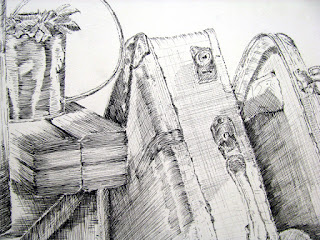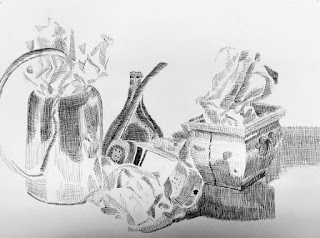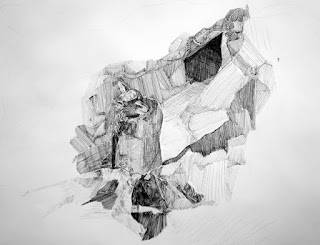Progressing from the use of your ink pen for hatched value, we will now be moving into the use of charcoal to achieve a much more subtle and complex expression of value. Beginning in today's class, you will be spending a total of three class periods developing a drapery study. There is a rich tradition of artists exploring value through the study of drapery. Fabric can be arranged to fall in such a way that a complex surface results, allowing light to settle on that surface to create a landscape of complex value relationships. The folds can create edges and little caverns that hold shadow, in addition to creating shapes of value that activate the composition. Additionally, the drapery can contain patterns, such as raised stitching or ridges, that magnify the changes in surface contour. Historically, the drapery study has been executed in service of larger projects-- Leonardo da Vinci's numerous studies were preliminary investigations to better understand how drapery can relate to the human form that he was depicting in his painted works.
When creating your own drapery study, begin with the usual practice of composing a series of thumbnail sketches in which you will consider how to fill the entirety of your picture plane with the drapery. Consider where you will crop your image-- see the shadows and folds as elements within a composition of interlocking shapes. Consider how those interlocking shapes fit within your composition. After you settle on a composition, very lightly and loosely sketch the drapery onto your paper with graphite. Do not press hard or erase any lines-- this will affect how your charcoal adheres to the surface of your paper. If, for instance, you draw a hard line and then erase it, when you place your charcoal down, it will not settle into where your line was drawn-- you've essentially inscribed a "trench" into your paper that will show up as a white line.
After you create this sketch-- which should take no more than ten minutes, begin building your value using your charcoal. Build light toward dark. If you go dark too quickly, you cannot go back to light very easily or most of the time at all. Layer your value and build to the darkest parts. In manipulating the subtle range you need to achieve-- you must make use of your blending sticks to create transitions, your chamois to lightly remove and smooth out areas of value, and your blue kneaded rubber eraser to lift, not to erase, value. The kneaded rubber eraser picks up charcoal-- do not try to use it like your white rubber eraser.
Your goal is to achieve is balanced range of value so that your study is not too dark or not too light, but is a successful balance between light and dark contrasts with equal emphasis on all of the parts of value discussed in class, including the highlights and any reflected light.
Important note: Please remember that shadows are transparent, not opaque. Since we are not working with the complete absence of light, if you are looking carefully, and thinking carefully about building your value, you will see information beneath a show. Think of the shadow as a projection that is laying atop your fabric, and that are still able to see some of that fabric through the shadow.
I've provided an example of a drapery study below, created by a student last semester. The top image is the full study, followed by a series of details. This will be the same piece of fabric you will be using, so please take not of how the student has used value to carefully define the ridges on this sheet.















































